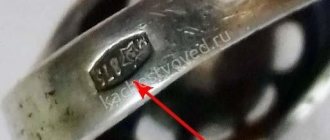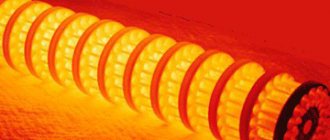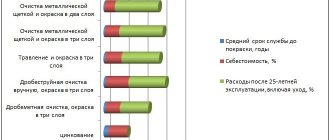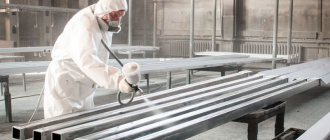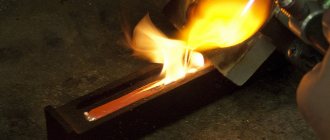How to determine the hardness of a metal at home - Metals, equipment, instructions
Mechanical engineering parts and mechanisms, as well as tools intended for their processing, have a set of mechanical characteristics. Hardness plays a significant role among the characteristics. The hardness of metals clearly shows:
- wear resistance of metal;
- possibility of processing by cutting, grinding;
- resistance to local pressure;
- ability to cut other materials and others.
Hardness of metals
In practice, it has been proven that most of the mechanical properties of metals directly depend on their hardness.
Hardness concept
The hardness of a material is its resistance to destruction when a harder material is introduced into the outer layer. In other words, the ability to resist deforming forces (elastic or plastic deformation).
The hardness of metals is determined by introducing a solid body called an indenter into a sample. The role of the indenter is performed by: a metal ball of high hardness; diamond cone or pyramid.
After exposure to the indenter, an imprint remains on the surface of the test sample or part, the size of which determines the hardness. In practice, kinematic, dynamic, and static methods of measuring hardness are used.
The kinematic method is based on the compilation of a diagram based on continuously recorded readings that change as the tool is pressed into the sample. Here the kinematics of the entire process is traced, and not just the final result.
The dynamic method is as follows. The measuring tool acts on the part. The reverse reaction allows you to calculate the expended kinetic energy. This method allows you to test the hardness of not only the surface, but also a certain volume of metal.
Static methods are non-destructive methods that allow you to determine the properties of metals. The methods are based on smooth indentation and subsequent holding for some time. The parameters are regulated by methods and standards.
The applied load can be applied:
- pressing;
- scratching;
- cutting;
- rebound
Machine-building enterprises currently use the Brinell, Rockwell, Vickers methods, as well as the microhardness method, to determine the hardness of materials.
Based on the tests carried out, a table is compiled indicating the materials, the applied loads and the results obtained.
Hardness Units
Each method of measuring the resistance of a metal to plastic deformation has its own methodology, as well as units of measurement.
The hardness of soft metals is measured using the Brinell method. Non-ferrous metals (copper, aluminum, magnesium, lead, tin) and alloys based on them, cast iron (except for white) and annealed steel are subjected to this method.
Brinell hardness is determined by indentation of a hardened, polished ball made of ShKh15 ball bearing steel. The circumference of the ball depends on the material being tested. For hard materials - all types of steel and cast iron - 10 mm, for softer materials - 1 - 2 - 2.5 - 5 mm. Required load applied to the ball:
- iron alloys – 30 kgf/mm2;
- copper and nickel – 10 kgf/mm2;
- aluminum and magnesium – 5 kgf/mm2.
The unit of hardness measurement is a numerical value followed by a numerical index HB. For example, 200 NV.
Rockwell hardness is determined by the difference in applied loads to the part. First, a preliminary load is applied, and then a general load, at which the indenter is introduced into the sample and held.
A pyramid (cone) of diamond or a ball of tungsten carbide (hardened steel) is introduced into the test sample. After removing the load, the depth of the indentation is measured.
The unit of measurement for hardness is conventional units. It is generally accepted that one is the amount of axial displacement of the cone, equal to 2 μm. The hardness designation is marked with three letters HR (A, B, C) and a numerical value. The third letter in the marking indicates the scale.
The technique reflects the type of indenter and the load applied to it.
| Scale type | Tool | Applied load, kgf |
| A | Diamond cone with 120° apex angle | 50-60 |
| IN | 1/16" ball | 90-100 |
| WITH | Diamond cone with 120° apex angle | 140-150 |
Basically, measurement scales A and C are used. For example, the hardness of steel is HRC 26...32, HRB 25...29, HRA 70...75.
Products of small thickness or parts with a thin, hard surface layer are measured by Vickers hardness. The blade used is a regular tetrahedral pyramid with an apex angle of 136°. The display of hardness values is as follows: 220 HV.
Hardness measurement using the Shore method is carried out by measuring the rebound height of a fallen striker. Indicated by numbers and letters, for example, 90 HSD.
Microhardness is determined when it is necessary to obtain the values of small parts, thin coatings, or individual alloy structures. The measurement is made by measuring the imprint of a tip of a certain shape. The value notation looks like this:
Н□ 0.195 = 2800, where
Checking the quality of knives at home
At home, you can test a newly purchased knife more rigorously. No one will look at you askance, since you have already bought the knife. Just don’t confuse the test with competitions to test strength and sharpness, where knives are actually often killed.
Bread cutting test
- one of the most common. You need to take a fresh and soft loaf and cut it into thin pieces. You will be surprised when you realize that not every knife can cope with this task. If a folding knife is being tested, then the loaf must first be cut into pieces so that the length of the blade is enough to pass the short blade of the folder (folding knife).
Tomato test
. A sharp knife should not just cut the tomato, the pieces should be extremely thin. If the knife is well sharpened, then the blade should cut the tomato even without pressure, under its own weight.
Plastic bottle test
and a tin can. This test is used to determine the hardness of the blade. Take a plastic bottle without a neck and cut it in the same way as a paper sheet. If you manage to cut the entire bottle without the blade becoming dull, then the knife is really good. The second test in this category is more stringent - cutting a tin can. Personally, I am against cutting tin with knives, especially opening cans, they are not intended for that. Before starting the test, you need to trim the tight edge of the jar. A good knife should cut tin as well as plastic. If you have a blade with a sharpening angle of 20 degrees, I would think 10 times before cutting tin. Correcting kinks on the cutting edge is not an easy task.
Wire cutting
or twisted pair. This is also a very controversial test, I would not use it. The knife must be sharp, and manipulation of the wires will quickly dull the blade. Despite this, there are many knives that do this without much impact on sharpening. The paradox is that high-quality blades are expensive, and few people would agree to test a knife so harshly for 20 thousand rubles or more.
Corrosion resistance test
. Determines the blade's resistance to corrosion. You need to prepare a concentrated solution of salt and water and soak the blade in it. Without wiping the knife, you need to leave it in this state for some time. This is also a rather controversial test. If the steel is stainless, then nothing will happen to the knife in a couple of hours, although if you leave it overnight, then rust spots may appear on the stainless steel. Steels that are not resistant to corrosion are guaranteed to be covered with rusty spots, and you will have to clean it and polish the blade. Just buy a knife made of steel with the properties you need, and you don't need to do any corrosion resistance tests.
How to determine the hardness of metal at home
Mechanical engineering parts and mechanisms, as well as tools intended for their processing, have a set of mechanical characteristics. Hardness plays a significant role among the characteristics. The hardness of metals clearly shows:
- wear resistance of metal;
- possibility of processing by cutting, grinding;
- resistance to local pressure;
- ability to cut other materials and others.
Hardness of metals
In practice, it has been proven that most of the mechanical properties of metals directly depend on their hardness.
Test two: cutting cans and bottles
This is an additional test for the strength of the blade. Here we do almost the same thing as in the first test - that is, we make the same movements, but only on a beer can or plastic bottle. Attention: before testing, these materials need to be prepared - cut off the tight top of the jar and the neck of the bottle. If the knife is good, it will be able to cut the container several times without additional sharpening. In this case, the blade should not be deformed, there should be no chips.
Cutting a tin can with a knife: a test that a well-sharpened knife must pass
How to check the quality of your knife without any extreme tests?
Today we will tell you how to check the quality of a knife in just a few minutes. Some of these tests can be done right in the store, some only at home. I’ll say right away that you can doubt the effectiveness of some of these tests, but if you really want to, you can try them.
How to choose a knife in general
Before purchasing a knife, you should decide for what purposes you will use it. If it is a sharp cutter, then you should not test it too hard; the minimum sharpening angle will not withstand such abuse, no matter what kind of steel is on this knife. You need to understand how much you can spend on a knife. Two blades made of different steels that are completely identical in appearance will cut differently. The higher quality the steel, the more durable the cutting edge will be.
What to choose, my eyes run wild
Much depends on what kind of slope the blade has. If you plan to use the knife mainly for food, then Scandinavian blades are not the best option, although they are ideal for a universal knife. I’ll say right away about the Scandinavians - it’s not just my opinion that they are the best universal knives in the world, this turns out to be the case based on international statistics.
Before buying a knife, ask the seller if he will allow you to test the knife for sharpness, at least in “light” mode. No one will let you cut wire and “loaf” logs, but they should allow you to shred newspaper.
Tests you can do right in the store
The simplest test
, which can be done without prior preparation, is a shaving test for the hair on the forearm. You don’t even have to ask the seller for permission, just run the blade across your forearm. A well-sharpened knife will shave hair easily. You should not be afraid of this test, although it is scary to check the quality of sharpening on your hand for the first time. The main thing is not to press the blade on the skin and hold it at a certain angle. It’s difficult to explain this in words, just try it and everything will work out (just be careful!).
How to check a knife (knife quality tests)
Photo
Nowadays knife lovers in Russia have many opportunities to choose and buy a knife that they like. This can be done both in stores and via the Internet; you can choose a knife from a budget or an expensive one, a serial model or a product from craftsmen. There are many forums and conferences where knife lovers discuss the advantages and disadvantages of models. There is a lot of information and it is almost impossible to keep track of everything. At almost all domestic conferences, questions about the quality of knives are often asked and discussed. This is interesting to everyone - both beginners and people in the know, because one person cannot buy or review all the knives...
Not long ago we were puzzled by the idea that it wouldn’t be a bad idea to have a set of tests that can be used to determine the quality of a blade. Both when purchasing it and later, compare it with other knives already available, calmly, at home. Tests should be simple (without fancy equipment or the use of serious tools), short in time, and correct. They should more or less reliably determine any characteristics of the click - hardness, RC resistance, etc. We understand that testing issues have been raised several times, at various conferences, but have never been reflected in this particular aspect.
Now the test suite itself. We will be very glad if they help someone.
TEST No. 1
Wipe the blade dry and clean on anything. And breathe on it. Then watch the perspiration go away. It should go smoothly and lie flat without holes or crooks. This indicates that the steel is homogeneous (which means that not just anything is used).
A comment:
It is better to do the test more than once and in different places on the blade. On a narrow blade (for example, Victorinox), the removal of stains can be quite equal - it’s worth doing more tests. It’s worth looking, and it’s the perspiration, scratches and unerased stains on the blade that can distort the picture, so it’s worth choosing a viewing angle such that these flaws are less visible.
TEST No. 2
Press with your thumbnail perpendicular to the steel. No matter how polished it is, there is some strange feeling of dull pain when you crush a well-hardened piece of iron. There is a scientific explanation for this, but it would take a long time to write.
A comment:
It feels like the faster the feeling of pain occurs in the nail, the better the hardening.
TEST No. 3
The sound of a blade. Bring the tip of the blade to your ear and use the pad of your thumb to gently stroke across the cutting edge. The blade should be free (do not pinch it between your fingers). A good blade, at least a little, makes a high-pitched ringing sound. Additionally, you can lightly click the blade with your fingernail, and it should also ring. This is precisely a sign of good hardening.
A comment:
It is better to hang the knife freely on a cord. The handle dampens the sound. In folding ones, this effect is stronger, apparently due to the movable connection.
TEST No. 4
Holding a copper coin (such as an old five-kopek coin) in your hand, without showing it to the seller, you need to discreetly cut shavings from it with a blade. It cuts cleanly and lasts a long time, which means the steel is well-hardened and the steel “holds.” If it first catches and then starts sliding, it means that the primary sharpness quickly sat on the coin, and the steel is either of poor quality or poorly hardened. If it doesn’t take it at all, then the knife is either dull (in general, a hardened and dull one will take it like a scraper), or it’s so soft that it can’t handle such activities.
A comment:
It appears that this test should be performed with a small portion of the blade near the heel. In small areas, it is more reliable to determine the resistance of the RA “by coin”. And the main part of the RC will remain intact, and this may be needed, so that they don’t swear in the store, and for further tests. The coin and blade meet at approximately 45 degrees. A good result can be considered a passage of 1/4 of the coin’s circumference or more, removing 1/2 - 1/3 of its thickness. It is useful to visually assess the blockage of the roller during and after planing.
TEST No. 5
Cut a simple household insulated two-core wire with copper cores. Before the first cut, test the cut with a newspaper blade and determine how you feel about it. And after each cut of the wire on a newspaper, check the cutting properties of the blade. If the blade shrinks after the 1st or 2nd cut, then the steel is bad. If after 3 cuts of the wire the blade becomes a little duller, then the steel is satisfactory. If after 5-6 cuts there are no signs of dulling or they are not significant, then we consider the steel to be good. Instead of a newspaper, you can visually inspect the RC for dullness (shine of the RC), but it seems that a visual assessment is much more difficult than cutting a newspaper.
How to test the hardness of metal - the main secrets
When it comes to metals, an important indicator is its hardness. A factor of this kind plays a significant role in the choice of whether or not to use a particular metal in production for the manufacture of products for a specific purpose. It is worth understanding this issue in more detail, which requires testing the hardness of metal in the production line of various industries.
What is metal hardness
This concept refers to a characteristic closely related to metals and their alloys. This is the ability to resist damage when the top layer is synchronized with a harder metal. Based on this knowledge, various equipment and parts are manufactured that play a role in the durability of objects, structures, machines, and tools. Simply put, resistance to deformation. You can check this parameter in different ways.
Methods for testing metal hardness
Experts distinguish several options for checking characteristics:
- According to the Brinnell method, a steel ball takes part in the verification process. It is pressed under great pressure into a metal surface. Then a special magnifying glass comes into effect, and with its help the specialist measures the diameter of the hole. Hardness is determined from tabular data. This method is the first method for determining the nature of the metal. This is how soft alloys are measured.
- Rockwell's technique involves impacting a metal surface with a diamond cone. A special press is used to measure the hardness of soft, colored, thin Me. It is not considered very accurate, although it is successfully used for the study of hard alloys.
- Similar actions to the previous one are included in the Vikxer method, which involves turning to a diamond pyramid, only the angle of the top is not 120, but 136 degrees. The load is carried out strictly perpendicular to the metal and increases slowly. Refers to high-precision methods.
- Shore's method involves the presence of a striker with a diamond-coated tip. It falls from a specific height onto the surface of the material being tested. Hardness is measured by the height of the striker's rebound. This methodology is distinguished by a large scatter of readings; for the most part it is used to measure curved objects and large parts.
At home, the indicator is also measured, but you should not expect high accuracy. When you turn to professionals, you can get a highly accurate result, and this is a crucial moment. Some conduct home education to determine this value, using an ordinary bottle and scratching it with a metal object, for example, a knife blade. Metal of 62 units easily scratches glass, which cannot be said about 56 units.
What does the hardness of the metal indicate, what does it give
The question arises as to why this parameter needs to be measured at all. The characteristics of metals are important to those involved in the steel heat treatment industry. The conclusion about the mechanical properties of the weld is also obtained by studying the heat-affected surface.
The feasibility of the research being carried out is also predetermined by the intention of manufacturers to obtain high-strength products so that they can withstand different operating conditions, temperature changes, and ensure reliability. The hardness of a metal product is a primary structural characteristic.
Research is carried out with the following objectives.
- Analyze the state of the material under the influence of time.
- Obtain knowledge of likely destructive consequences to improve operational capabilities.
- Monitor the results obtained as part of the temperature treatment.
According to the information acquired during the experiments, it is possible to determine the resistance to abrasion and wear of the source material.
Conclusion
To carry out the analysis, certain conditions are imposed on the material being tested. In particular, the workpiece is selected to be even. It should fit tightly to the hardness tester, with carefully processed edges. As a result, fundamental mechanical quality is achieved, which plays a role in the production of high-quality products.
Specialists use the results obtained during the study, compare them with previously known analysis, and this is a lot of work that helps determine the production method. Information is necessary for mechanical engineering, metalworking, and metallurgical enterprises. The concept of “hardness” is associated with elasticity, plasticity, and strength, although there is no direct connection between mechanical qualities.
It is important to turn to professionals to perform such work; the home method is only suitable for tasks of hardening knives.
Source: https://rosgranitsa.ru/stroitelstvo/raznoe-2/kak-proverit-tverdost-metalla-glavnye-sekrety/
What does the hardness of the metal indicate, what does it give
The question arises as to why this parameter needs to be measured at all. The characteristics of metals are important to those involved in the steel heat treatment industry. The conclusion about the mechanical properties of the weld is also obtained by studying the heat-affected surface.
The feasibility of the research being carried out is also predetermined by the intention of manufacturers to obtain high-strength products so that they can withstand different operating conditions, temperature changes, and ensure reliability. The hardness of a metal product is a primary structural characteristic.
Research is carried out with the following objectives.
- Analyze the state of the material under the influence of time.
- Obtain knowledge of likely destructive consequences to improve operational capabilities.
- Monitor the results obtained as part of the temperature treatment.
According to the information acquired during the experiments, it is possible to determine the resistance to abrasion and wear of the source material.
Hardness of metals
Mechanical engineering parts and mechanisms, as well as tools intended for their processing, have a set of mechanical characteristics. Hardness plays a significant role among the characteristics. The hardness of metals clearly shows:
- wear resistance of metal;
- possibility of processing by cutting, grinding;
- resistance to local pressure;
- ability to cut other materials and others.
Hardness of metals
In practice, it has been proven that most of the mechanical properties of metals directly depend on their hardness.
